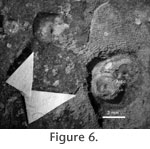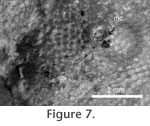Results
 The Ohesaare hardground is formed from an intrabiosparite containing skeletal debris (brachiopods, bryozoans, echinoderms, mollusks, trilobites, ostracodes, and Tentaculites), as well as biomicritic intraclasts. The echinoderm fragments show much syntaxial overgrowth cement. Some parts of the hardground are composed of pure sparitic cement. Bioclasts in the hardground are abraded both on the upper and cryptic sides. The hardground surface is abraded (Figure 4). The crypts are formed under the hardground ledges and are up to 10 cm wide. The hardground ledges are 3 to 30 mm thick. The hardground has a moderate relief (Figure 4). The Ohesaare hardground is formed from an intrabiosparite containing skeletal debris (brachiopods, bryozoans, echinoderms, mollusks, trilobites, ostracodes, and Tentaculites), as well as biomicritic intraclasts. The echinoderm fragments show much syntaxial overgrowth cement. Some parts of the hardground are composed of pure sparitic cement. Bioclasts in the hardground are abraded both on the upper and cryptic sides. The hardground surface is abraded (Figure 4). The crypts are formed under the hardground ledges and are up to 10 cm wide. The hardground ledges are 3 to 30 mm thick. The hardground has a moderate relief (Figure 4).
 The microrelief is bumpy (Figure 5). There are possible microborings in both surfaces of the hardground. Some parts of the hardground surface are darker than others. There are linear calcite-filled fractures and mud-filled crevices and ledges. The encrusting microconchids (broken tubes) show marks of slight abrasion (Figure 5). The hardground is covered by light-colored bluish soft marl containing numerous fragments of crinoid columnals, articulate brachiopods, and some fish scales. The microrelief is bumpy (Figure 5). There are possible microborings in both surfaces of the hardground. Some parts of the hardground surface are darker than others. There are linear calcite-filled fractures and mud-filled crevices and ledges. The encrusting microconchids (broken tubes) show marks of slight abrasion (Figure 5). The hardground is covered by light-colored bluish soft marl containing numerous fragments of crinoid columnals, articulate brachiopods, and some fish scales.
The hardground association has a moderate diversity comprising: two species of microconchids (Palaeoconchus cf. tenuis and Palaeoconchus sp.) (Figure 6), Anticalyptraea calyptrata (Figure 6), Cornulites sp., Conchicolites sp., sheet-like trepostome bryozoans (Figure 6 and
Figure 7), discoidal crinoid holdfasts, encrusting graptolites, tabulate Aulopora sp., Trypanites borings (Figure 5),
 and probably also cementing brachiopods. Microconchid tubeworms dominate in abundance (Table 1). The hardground association shows a moderate taxonomic polarity between the upper surface and cryptic communities (Table 1 and
Table 2). and probably also cementing brachiopods. Microconchid tubeworms dominate in abundance (Table 1). The hardground association shows a moderate taxonomic polarity between the upper surface and cryptic communities (Table 1 and
Table 2).
Trypanites range from 0.50 to 2.50 mm in diameter and extend to a maximum depth of 0.5 cm below the substrate surface (Figure 4.4) (Figure 5). There are usually 20 to 180 Trypanites borings per 5 cm2 of the hardground upper surface, but some areas (up to 5 cm2) have no borings (Figure 4.4). There are a maximum of three Trypanites per 5 cm2 on the cryptic surfaces of the hardground; most of these surfaces lack Trypanites (up to 20 cm2) (Figure 4.3).
The hardground is sparsely covered by encrusting fossils (Figure 4). The hardground cryptic surfaces were more densely populated by skeletal encrusters than the upper surfaces, 6.4 % of total surface area and 1.5 % of total surface area, respectively (Table 2).
 Sheet-like trepostome bryozoans showed a strong preference for cryptic roofs of hardground
ledges (Table 2) (Figure 6 and
Figure 7) as compared to upper surfaces. A. calyptrata (3.1 to 6.0 mm in diameter) also had a slight preference for cryptic conditions (Table 2) (Figure 6). In contrast, microconchids (0.8 to 2.9 mm in diameter) had a slight preference for hardground upper surfaces (v) (Figure 4.2) (Figure 5). The percent of microconchids in the total skeletal cover of hardground is several times higher in the upper surface community than it is in the cryptic community (Table 2) (Figure 6) (Figure 7). Sheet-like trepostome bryozoans showed a strong preference for cryptic roofs of hardground
ledges (Table 2) (Figure 6 and
Figure 7) as compared to upper surfaces. A. calyptrata (3.1 to 6.0 mm in diameter) also had a slight preference for cryptic conditions (Table 2) (Figure 6). In contrast, microconchids (0.8 to 2.9 mm in diameter) had a slight preference for hardground upper surfaces (v) (Figure 4.2) (Figure 5). The percent of microconchids in the total skeletal cover of hardground is several times higher in the upper surface community than it is in the cryptic community (Table 2) (Figure 6) (Figure 7).
The distribution of encrusting fauna on the hardground is patchy, both on upper surfaces and underneath hardground ledges (Figure 4.1-4.2). Distribution of Trypanites borings (bioerosion) is also patchy on the upper surfaces. Trypanites borings are rare underneath hardground ledges. High Trypanites densities are found both with very low (Figure 4.1) to high microconchid encrustation frequencies on upper surfaces (Figure 4.2).
Five cases of skeletal overgrowth occur between different encrusting species, four in the cryptic community. All overgrowths occur between the specimens of different taxa. Two cryptic microconchids are overgrown by a sheet-like trepostome bryozoan, but they have elevated apertures, which remained free of the bryozoan skeleton (Figure 7). One sheet-like trepostome bryozoan has overgrown the aperture of one specimen of A. calyptrata, while the other specimen of A. calyptrata which is overgrown by bryozoans has an unencrusted aperture (Figure 6). A specimen of Aulopora sp. is almost completely overgrown by a sheet-like trepostome bryozoan. One upper surface microconchid is completely overgrown by a sheet-like trepostome bryozoan.
|